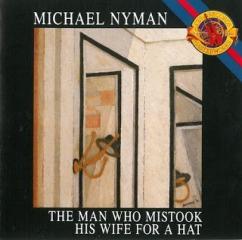Michael Nyman - The Man Who Mistook His Wife For A Hat (1988)
Michael Nyman - The Man Who Mistook His Wife For A Hat (1988)

01. Prologue: Neurology's favourite term 02. Traffic. Street sounds 03. [That's why] I'm here 04. Can I help? 05. And yet... and yet 06. You can see clearly 07. What do you see now? 08. Where was this hat? 09. ... [mistake his] wife for a hat? 10. Bosendorfer! 11. Ich grolle nicht 12. But what of the parietal regions? 13. What's the time? 14. What is this?... It's a square 15. What is this?... Six inches in length 16. Now, what is this? 17. Pawn to King 4 18. From our end, high up here 19. Your husband's a painter, I see 20. Ach! Tea from China, lovely fragrance 21. I cannot tell you what is wrong Performers: Dr. S, The Neurologist - Emile Belcourt, tenor Mrs. P - Sarah Leonard, soprano Dr. P - Frederick Westcott, baritone Michael Nyman Band Michael Nyman, piano & conducting
My first reading of the title text of The Man who Mistook his Wife for a Hat, soon after the book was published in Britain in November 1985, curiously mirrored the way its central character, Dr. P, viewed the world: I scanned it, skipped from page to page, incident to incident, fascinated by the details, but seeing the whole. These details, however, inescapably formed themselves into a new picture: an opera. Compositional challenges and solutions instantly emerged -as much from Sack’s layout of the case study as from ist subject. (My initial enthusiasm was not allowed to wane through the normal delays of opera funding and scheduling: the project was immediately accepted for production by Michael Morris at the Institute of Contemporary Arts (ICA) in London, and Channel 4 TV soon became involved with a film version directed by Christopher Rawlence and produced by Debra Hauer for the newly formed ICA TV. Rawlence, Morris and I began a treatment of Sack’s text, and Jock Scott’s designs had a formative influence on the shape of the work. Rawlence’s libretto explored areas only hinted at by Sacks, much to the enrichment of the work and to Dr. Sack’s satisfaction. From conception to first performance in October 1986 was less than a year.) What primarily interested me was that Sacks does not describe Dr. P’s neurological problem, but rather takes the reader through his own step by step discovery of the patient’s condition: narrative as process, demanding a parallel musical process. The text contains very little dierct portrayal of Dr. P’s daily experience of visual agnosia but instead reveals his affliction through a series of diagnostic tests conducted in two sessions -the first in Dr. Sack’s consulting room, the second at the home of Dr. and Mrs. P. Each test presents a new piece of diagnostic evidence and, in the opera, would be treated as an individual narrative event: each of these self-contained musical events would then be linked together into a large-scale sequential narrative -a number opera with a difference. My first preparatory step had been to carve up the case study into the Greeting Event, Shoe Event, Rose Event, etc., rather like Fluxus Events. ---Michael Nyman, michaelnyman.com
download: uploaded filecloudio anonfiles yandex 4shared solidfiles mediafire mega binge








